Dissertation: Leadership Skills, Training, and Personnel Performance
VerifiedAdded on 2020/12/10
|105
|21158
|439
Thesis and Dissertation
AI Summary
This dissertation presents a quantitative correlation study examining the relationship between management leadership skills, organizational-based training, and the performance of personnel. The study, adhering to best practices in quantitative research, utilized a survey questionnaire and SPSS 22.0 software to analyze data from 30 participants, including active-duty Army veterans and retired civil servants. The research focuses on the correlation between organizational leadership training, leadership skills, and customer service performance within Civilian Personnel Advisory Centers (CPACs). The study explores how leadership training impacts the skills of leaders managing personnel and how these skills, in turn, affect the performance of civilian employees. Findings, conclusions, and recommendations are detailed across chapters, including an extensive literature review and statistical results. The study highlights the importance of management skills and organizational training in enhancing personnel performance.
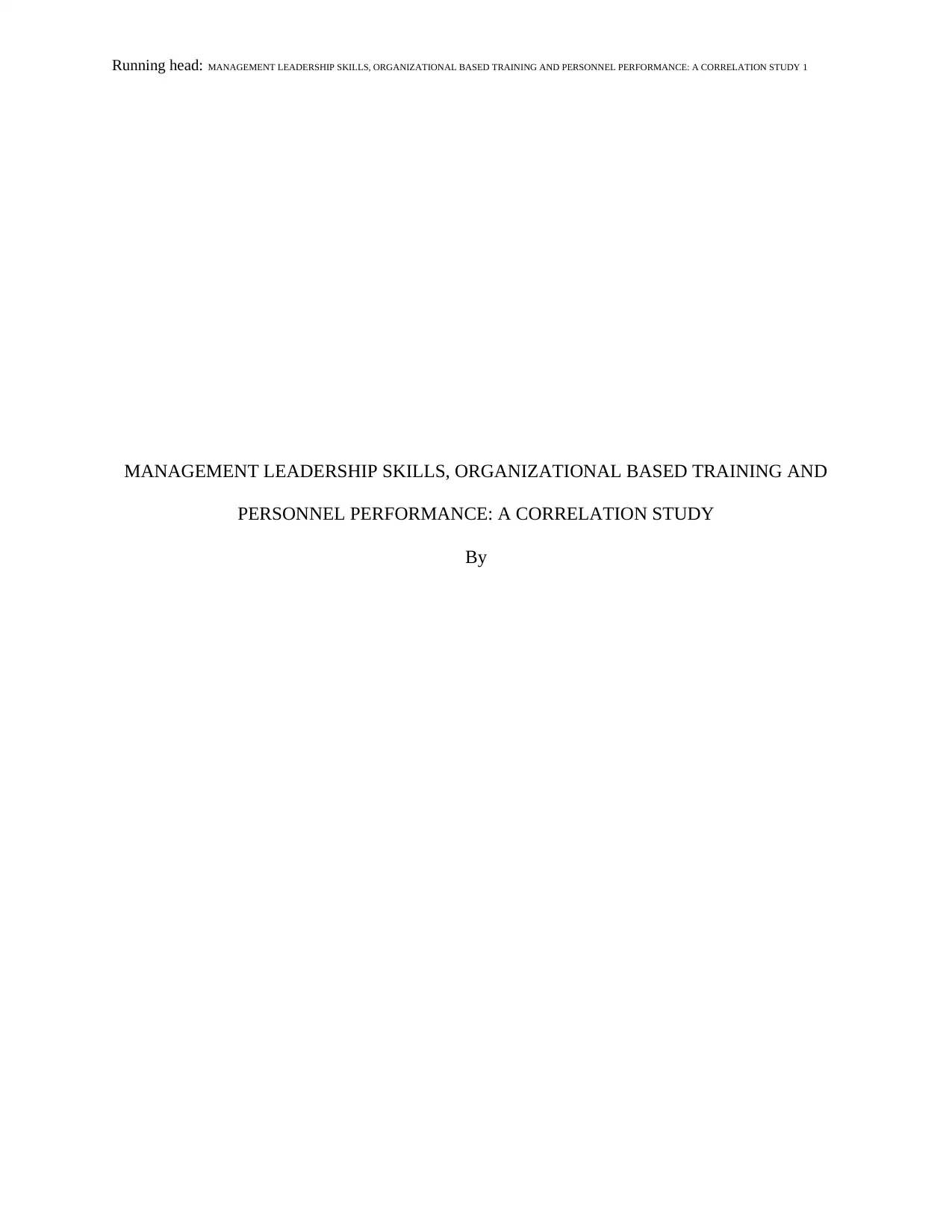
Running head: MANAGEMENT LEADERSHIP SKILLS, ORGANIZATIONAL BASED TRAINING AND PERSONNEL PERFORMANCE: A CORRELATION STUDY 1
MANAGEMENT LEADERSHIP SKILLS, ORGANIZATIONAL BASED TRAINING AND
PERSONNEL PERFORMANCE: A CORRELATION STUDY
By
MANAGEMENT LEADERSHIP SKILLS, ORGANIZATIONAL BASED TRAINING AND
PERSONNEL PERFORMANCE: A CORRELATION STUDY
By
Paraphrase This Document
Need a fresh take? Get an instant paraphrase of this document with our AI Paraphraser
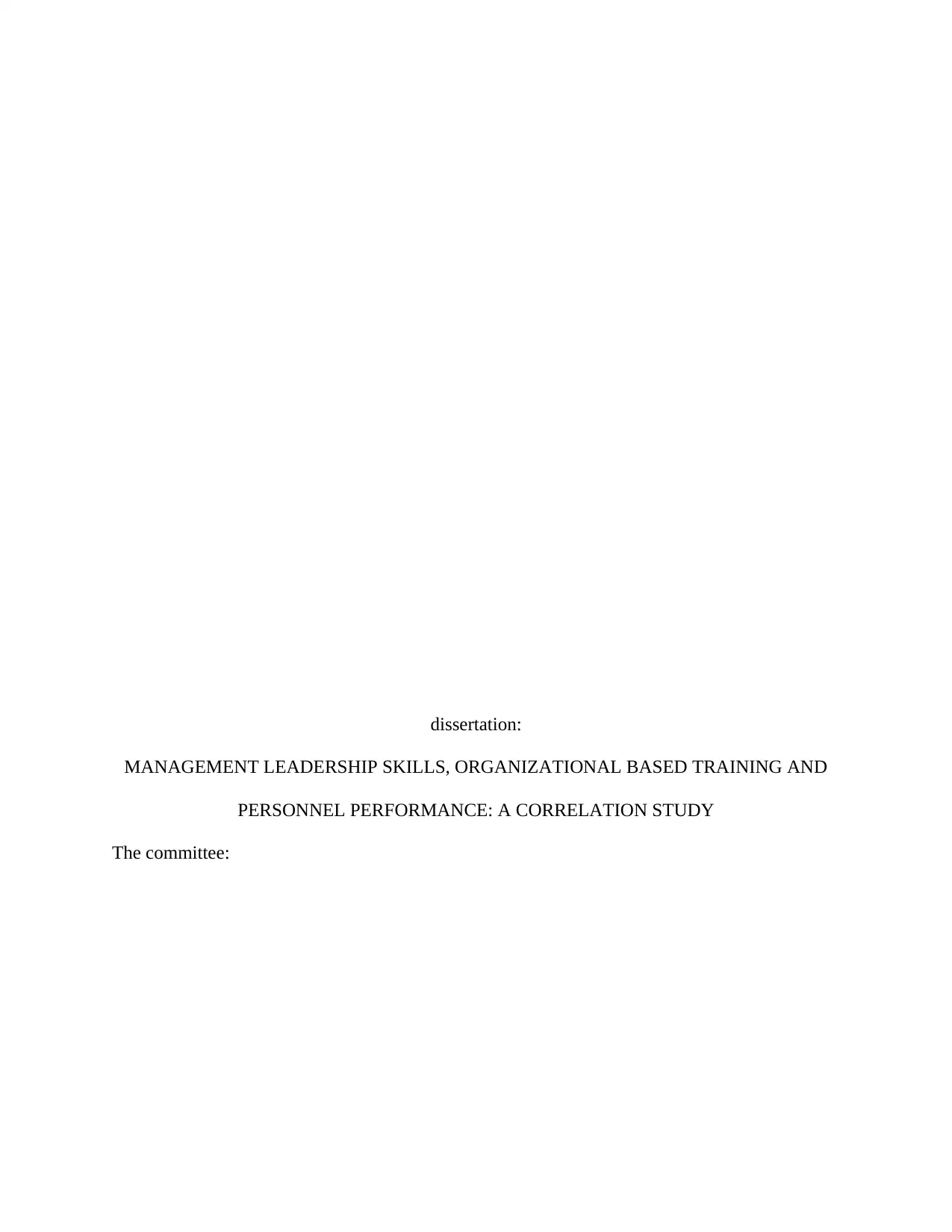
dissertation:
MANAGEMENT LEADERSHIP SKILLS, ORGANIZATIONAL BASED TRAINING AND
PERSONNEL PERFORMANCE: A CORRELATION STUDY
The committee:
MANAGEMENT LEADERSHIP SKILLS, ORGANIZATIONAL BASED TRAINING AND
PERSONNEL PERFORMANCE: A CORRELATION STUDY
The committee:
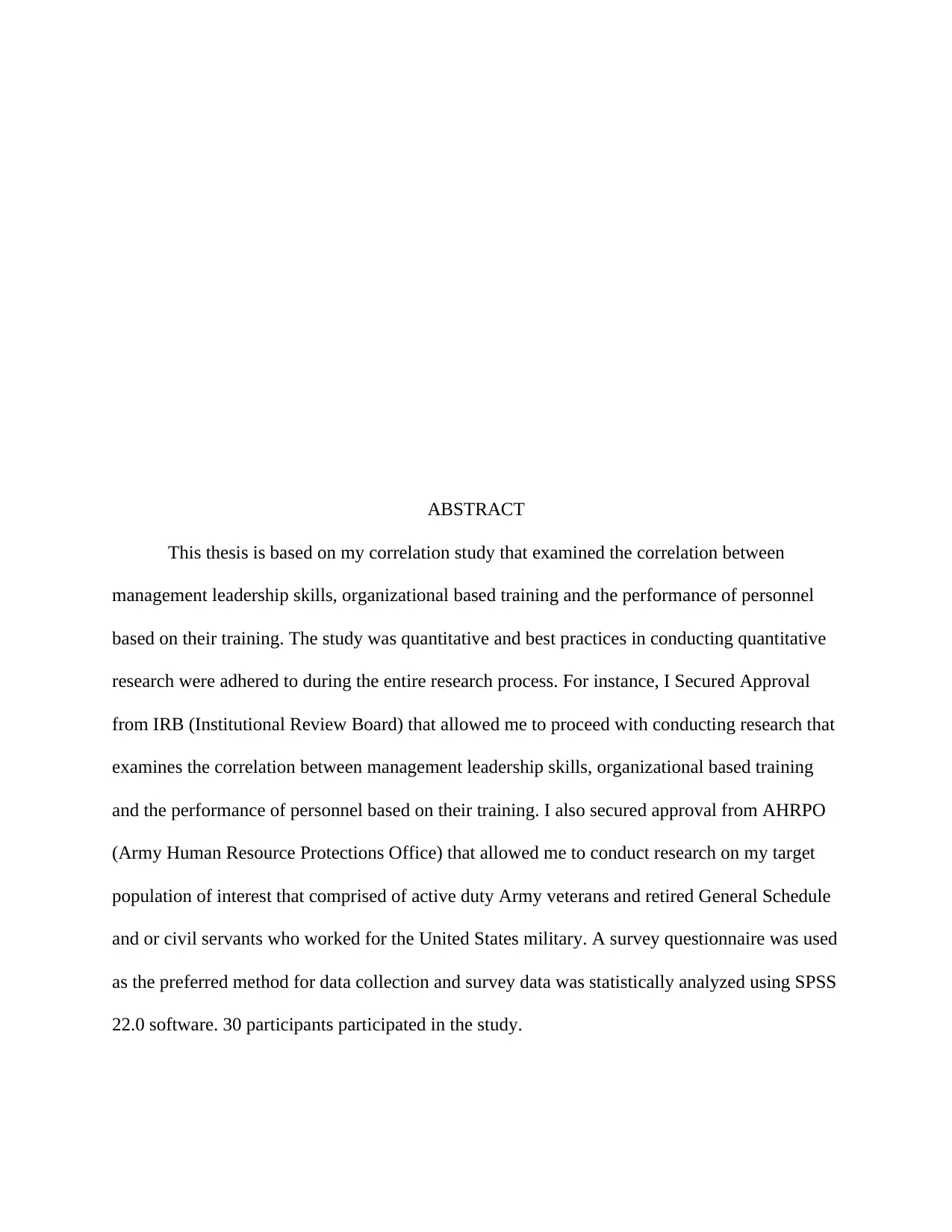
ABSTRACT
This thesis is based on my correlation study that examined the correlation between
management leadership skills, organizational based training and the performance of personnel
based on their training. The study was quantitative and best practices in conducting quantitative
research were adhered to during the entire research process. For instance, I Secured Approval
from IRB (Institutional Review Board) that allowed me to proceed with conducting research that
examines the correlation between management leadership skills, organizational based training
and the performance of personnel based on their training. I also secured approval from AHRPO
(Army Human Resource Protections Office) that allowed me to conduct research on my target
population of interest that comprised of active duty Army veterans and retired General Schedule
and or civil servants who worked for the United States military. A survey questionnaire was used
as the preferred method for data collection and survey data was statistically analyzed using SPSS
22.0 software. 30 participants participated in the study.
This thesis is based on my correlation study that examined the correlation between
management leadership skills, organizational based training and the performance of personnel
based on their training. The study was quantitative and best practices in conducting quantitative
research were adhered to during the entire research process. For instance, I Secured Approval
from IRB (Institutional Review Board) that allowed me to proceed with conducting research that
examines the correlation between management leadership skills, organizational based training
and the performance of personnel based on their training. I also secured approval from AHRPO
(Army Human Resource Protections Office) that allowed me to conduct research on my target
population of interest that comprised of active duty Army veterans and retired General Schedule
and or civil servants who worked for the United States military. A survey questionnaire was used
as the preferred method for data collection and survey data was statistically analyzed using SPSS
22.0 software. 30 participants participated in the study.
⊘ This is a preview!⊘
Do you want full access?
Subscribe today to unlock all pages.

Trusted by 1+ million students worldwide
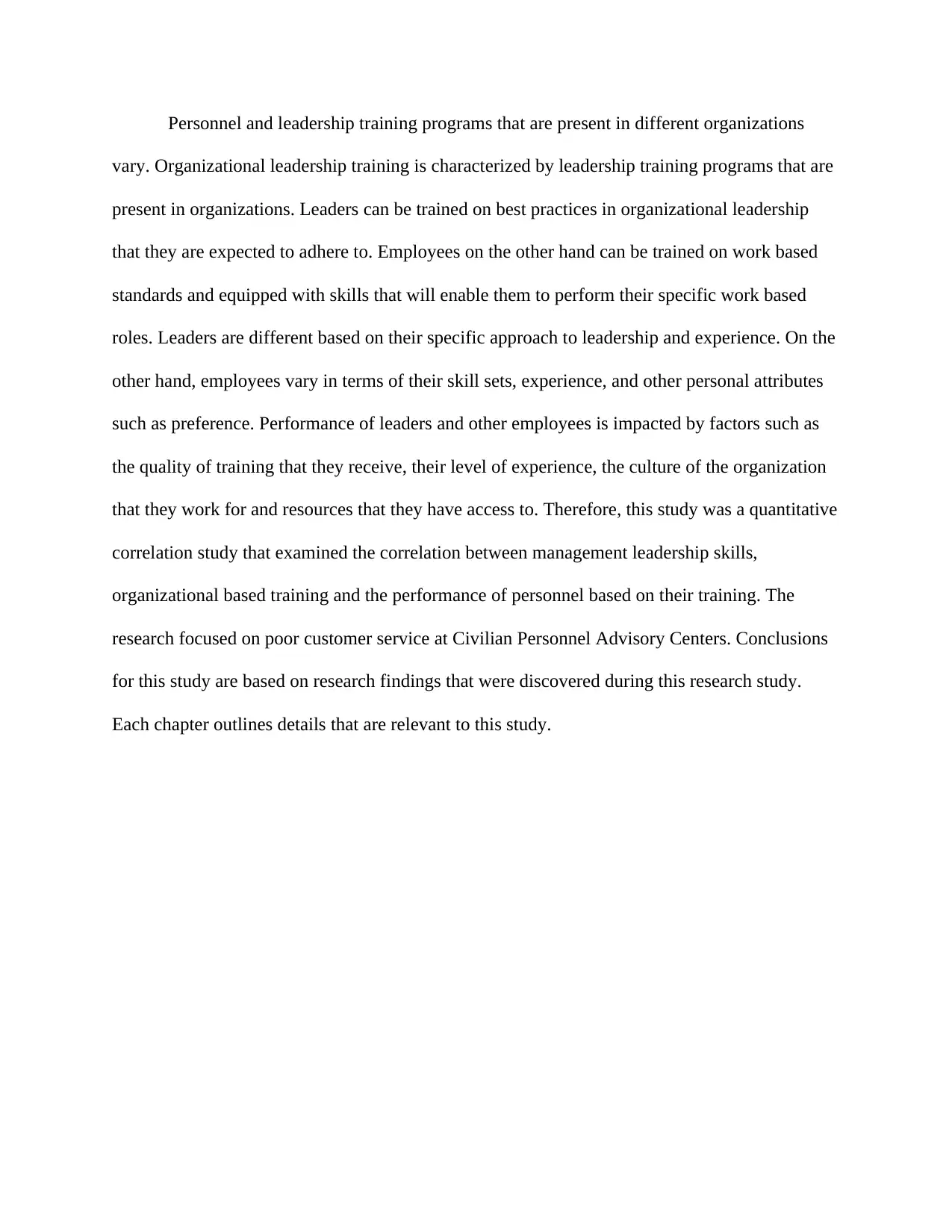
Personnel and leadership training programs that are present in different organizations
vary. Organizational leadership training is characterized by leadership training programs that are
present in organizations. Leaders can be trained on best practices in organizational leadership
that they are expected to adhere to. Employees on the other hand can be trained on work based
standards and equipped with skills that will enable them to perform their specific work based
roles. Leaders are different based on their specific approach to leadership and experience. On the
other hand, employees vary in terms of their skill sets, experience, and other personal attributes
such as preference. Performance of leaders and other employees is impacted by factors such as
the quality of training that they receive, their level of experience, the culture of the organization
that they work for and resources that they have access to. Therefore, this study was a quantitative
correlation study that examined the correlation between management leadership skills,
organizational based training and the performance of personnel based on their training. The
research focused on poor customer service at Civilian Personnel Advisory Centers. Conclusions
for this study are based on research findings that were discovered during this research study.
Each chapter outlines details that are relevant to this study.
vary. Organizational leadership training is characterized by leadership training programs that are
present in organizations. Leaders can be trained on best practices in organizational leadership
that they are expected to adhere to. Employees on the other hand can be trained on work based
standards and equipped with skills that will enable them to perform their specific work based
roles. Leaders are different based on their specific approach to leadership and experience. On the
other hand, employees vary in terms of their skill sets, experience, and other personal attributes
such as preference. Performance of leaders and other employees is impacted by factors such as
the quality of training that they receive, their level of experience, the culture of the organization
that they work for and resources that they have access to. Therefore, this study was a quantitative
correlation study that examined the correlation between management leadership skills,
organizational based training and the performance of personnel based on their training. The
research focused on poor customer service at Civilian Personnel Advisory Centers. Conclusions
for this study are based on research findings that were discovered during this research study.
Each chapter outlines details that are relevant to this study.
Paraphrase This Document
Need a fresh take? Get an instant paraphrase of this document with our AI Paraphraser
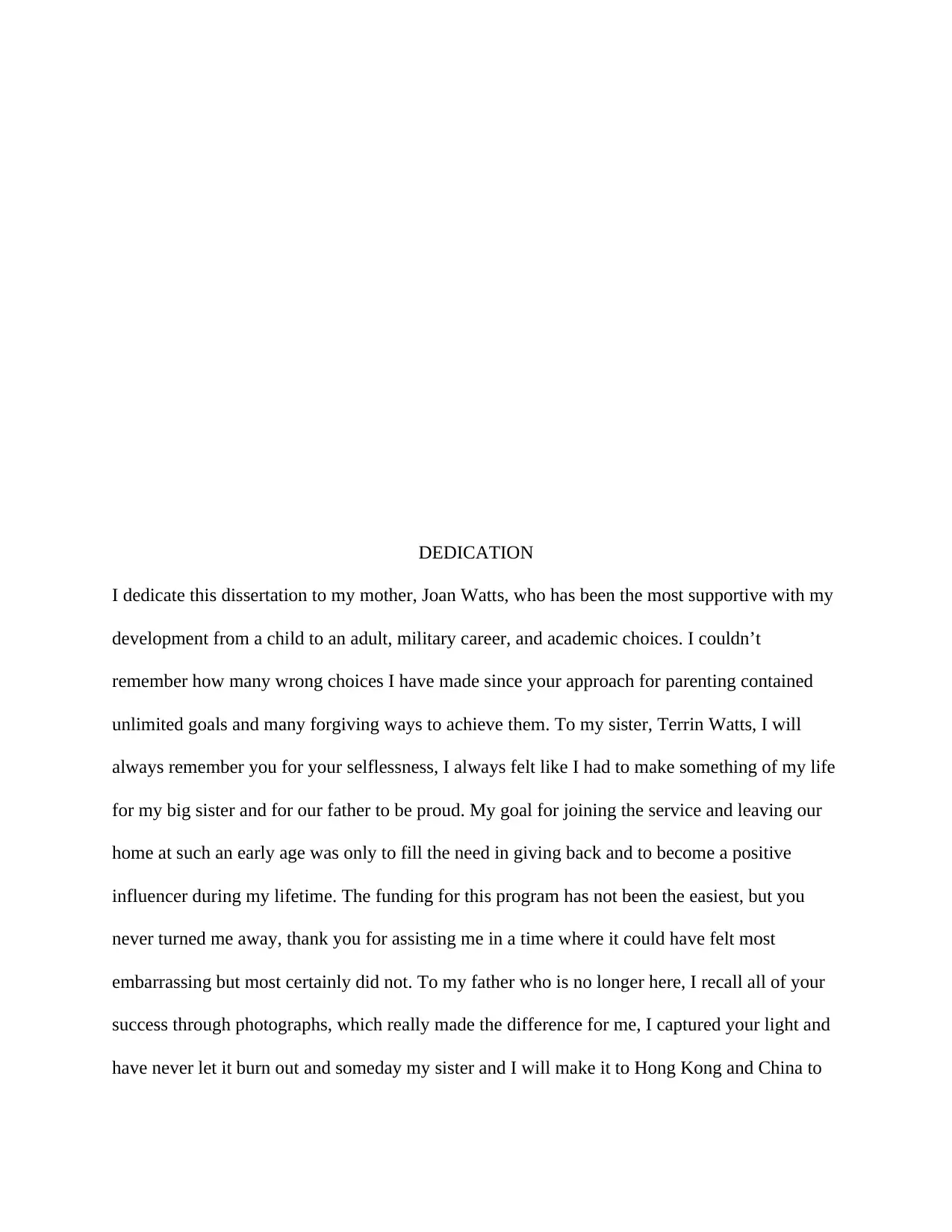
DEDICATION
I dedicate this dissertation to my mother, Joan Watts, who has been the most supportive with my
development from a child to an adult, military career, and academic choices. I couldn’t
remember how many wrong choices I have made since your approach for parenting contained
unlimited goals and many forgiving ways to achieve them. To my sister, Terrin Watts, I will
always remember you for your selflessness, I always felt like I had to make something of my life
for my big sister and for our father to be proud. My goal for joining the service and leaving our
home at such an early age was only to fill the need in giving back and to become a positive
influencer during my lifetime. The funding for this program has not been the easiest, but you
never turned me away, thank you for assisting me in a time where it could have felt most
embarrassing but most certainly did not. To my father who is no longer here, I recall all of your
success through photographs, which really made the difference for me, I captured your light and
have never let it burn out and someday my sister and I will make it to Hong Kong and China to
I dedicate this dissertation to my mother, Joan Watts, who has been the most supportive with my
development from a child to an adult, military career, and academic choices. I couldn’t
remember how many wrong choices I have made since your approach for parenting contained
unlimited goals and many forgiving ways to achieve them. To my sister, Terrin Watts, I will
always remember you for your selflessness, I always felt like I had to make something of my life
for my big sister and for our father to be proud. My goal for joining the service and leaving our
home at such an early age was only to fill the need in giving back and to become a positive
influencer during my lifetime. The funding for this program has not been the easiest, but you
never turned me away, thank you for assisting me in a time where it could have felt most
embarrassing but most certainly did not. To my father who is no longer here, I recall all of your
success through photographs, which really made the difference for me, I captured your light and
have never let it burn out and someday my sister and I will make it to Hong Kong and China to
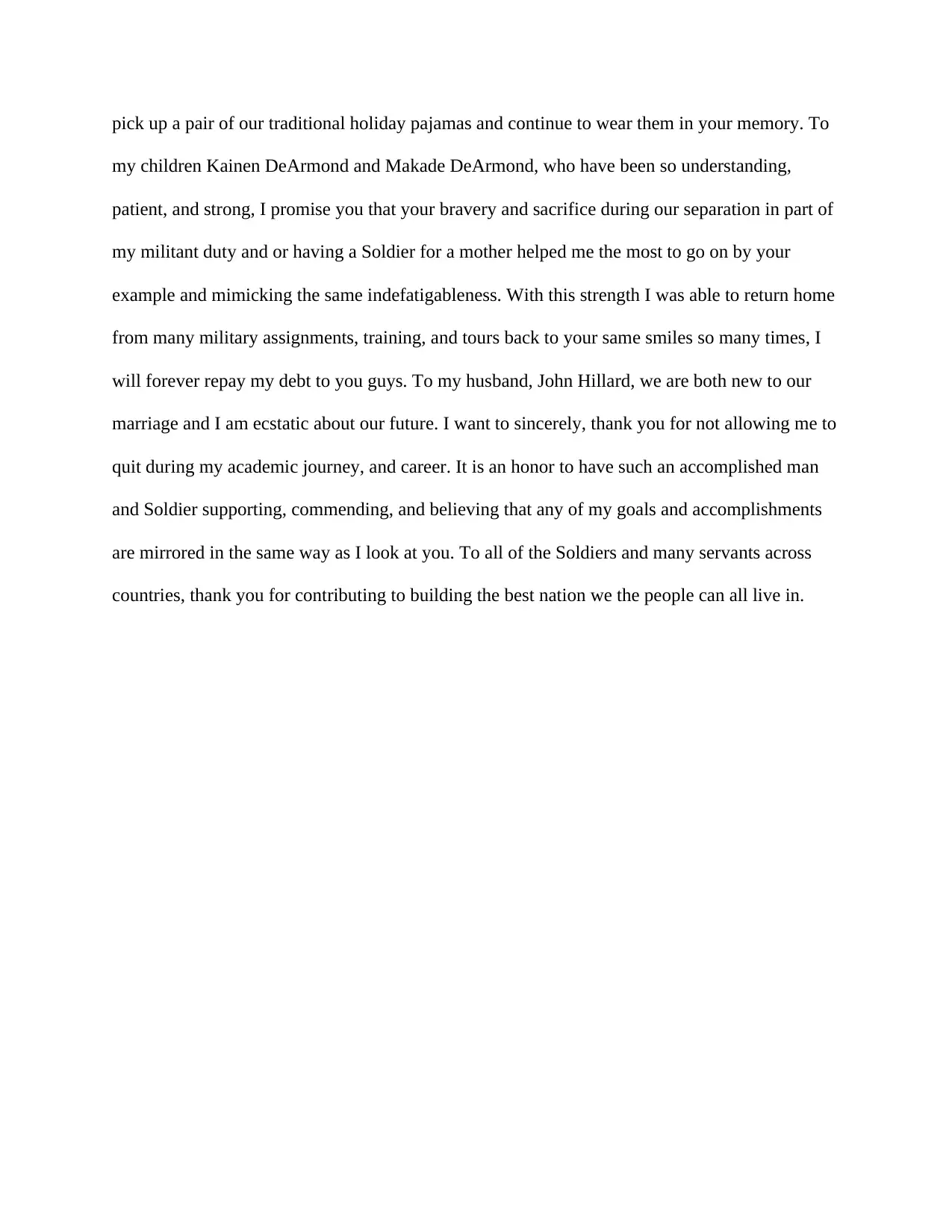
pick up a pair of our traditional holiday pajamas and continue to wear them in your memory. To
my children Kainen DeArmond and Makade DeArmond, who have been so understanding,
patient, and strong, I promise you that your bravery and sacrifice during our separation in part of
my militant duty and or having a Soldier for a mother helped me the most to go on by your
example and mimicking the same indefatigableness. With this strength I was able to return home
from many military assignments, training, and tours back to your same smiles so many times, I
will forever repay my debt to you guys. To my husband, John Hillard, we are both new to our
marriage and I am ecstatic about our future. I want to sincerely, thank you for not allowing me to
quit during my academic journey, and career. It is an honor to have such an accomplished man
and Soldier supporting, commending, and believing that any of my goals and accomplishments
are mirrored in the same way as I look at you. To all of the Soldiers and many servants across
countries, thank you for contributing to building the best nation we the people can all live in.
my children Kainen DeArmond and Makade DeArmond, who have been so understanding,
patient, and strong, I promise you that your bravery and sacrifice during our separation in part of
my militant duty and or having a Soldier for a mother helped me the most to go on by your
example and mimicking the same indefatigableness. With this strength I was able to return home
from many military assignments, training, and tours back to your same smiles so many times, I
will forever repay my debt to you guys. To my husband, John Hillard, we are both new to our
marriage and I am ecstatic about our future. I want to sincerely, thank you for not allowing me to
quit during my academic journey, and career. It is an honor to have such an accomplished man
and Soldier supporting, commending, and believing that any of my goals and accomplishments
are mirrored in the same way as I look at you. To all of the Soldiers and many servants across
countries, thank you for contributing to building the best nation we the people can all live in.
⊘ This is a preview!⊘
Do you want full access?
Subscribe today to unlock all pages.

Trusted by 1+ million students worldwide

Paraphrase This Document
Need a fresh take? Get an instant paraphrase of this document with our AI Paraphraser
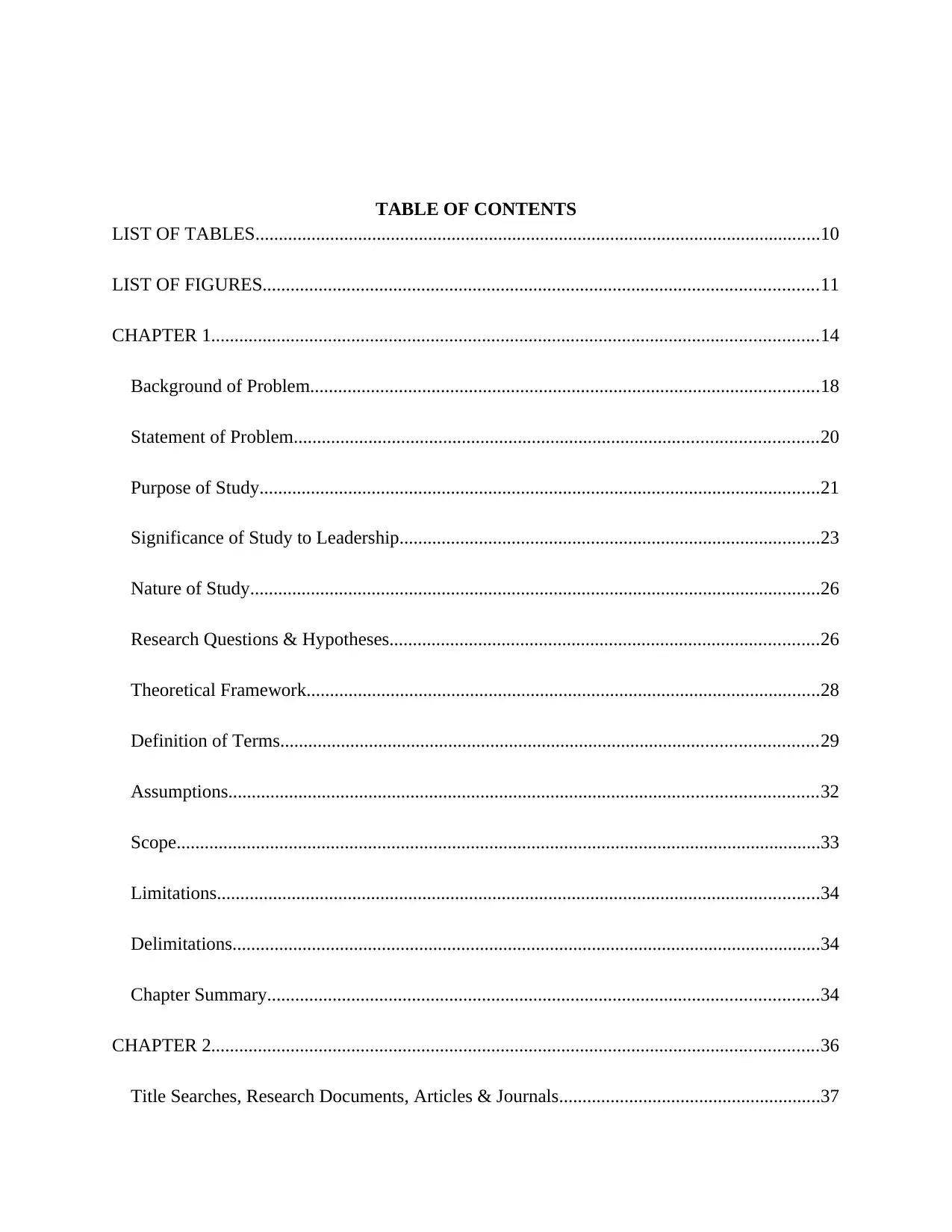
TABLE OF CONTENTS
LIST OF TABLES.........................................................................................................................10
LIST OF FIGURES.......................................................................................................................11
CHAPTER 1..................................................................................................................................14
Background of Problem.............................................................................................................18
Statement of Problem................................................................................................................20
Purpose of Study........................................................................................................................21
Significance of Study to Leadership..........................................................................................23
Nature of Study..........................................................................................................................26
Research Questions & Hypotheses............................................................................................26
Theoretical Framework..............................................................................................................28
Definition of Terms...................................................................................................................29
Assumptions..............................................................................................................................32
Scope..........................................................................................................................................33
Limitations.................................................................................................................................34
Delimitations..............................................................................................................................34
Chapter Summary......................................................................................................................34
CHAPTER 2..................................................................................................................................36
Title Searches, Research Documents, Articles & Journals........................................................37
LIST OF TABLES.........................................................................................................................10
LIST OF FIGURES.......................................................................................................................11
CHAPTER 1..................................................................................................................................14
Background of Problem.............................................................................................................18
Statement of Problem................................................................................................................20
Purpose of Study........................................................................................................................21
Significance of Study to Leadership..........................................................................................23
Nature of Study..........................................................................................................................26
Research Questions & Hypotheses............................................................................................26
Theoretical Framework..............................................................................................................28
Definition of Terms...................................................................................................................29
Assumptions..............................................................................................................................32
Scope..........................................................................................................................................33
Limitations.................................................................................................................................34
Delimitations..............................................................................................................................34
Chapter Summary......................................................................................................................34
CHAPTER 2..................................................................................................................................36
Title Searches, Research Documents, Articles & Journals........................................................37
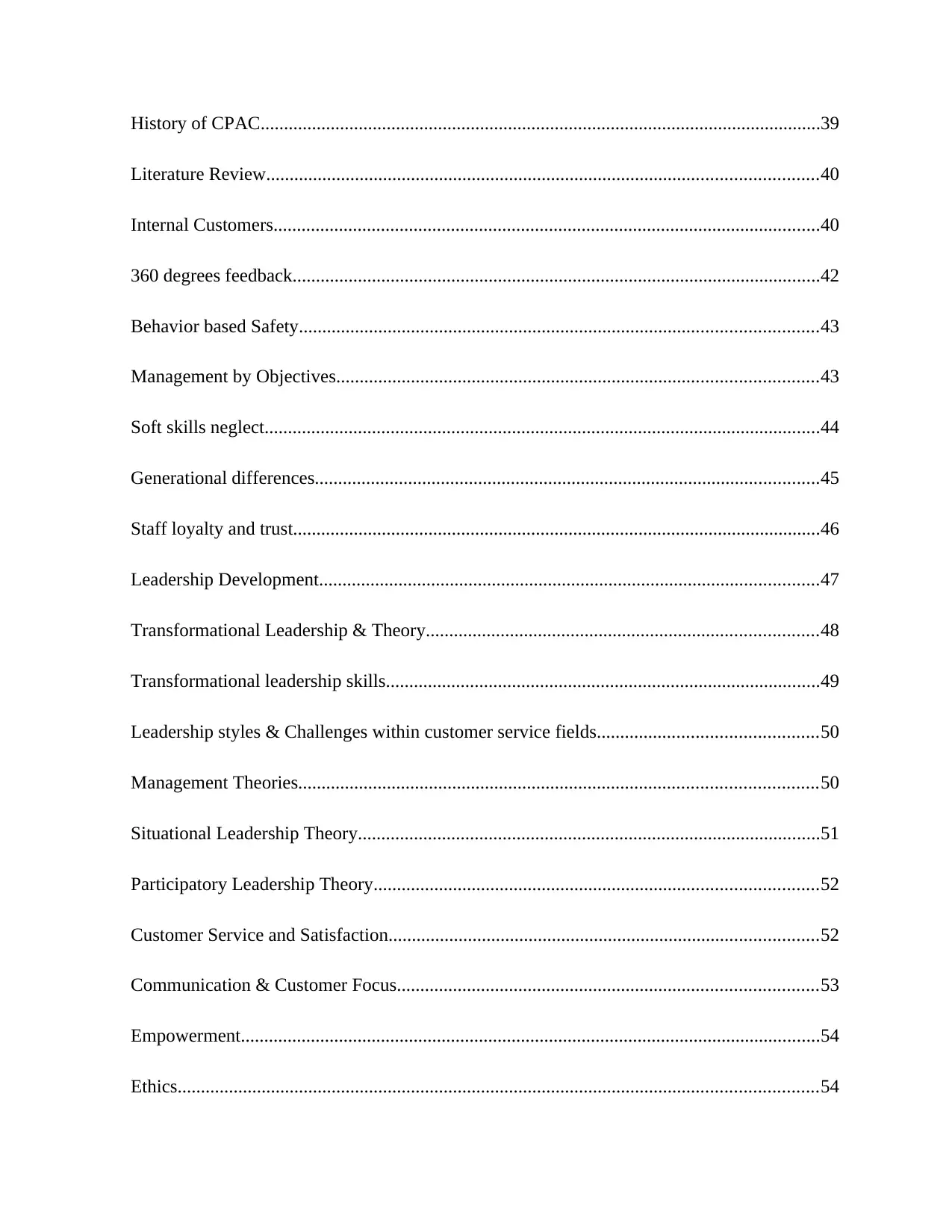
History of CPAC........................................................................................................................39
Literature Review......................................................................................................................40
Internal Customers.....................................................................................................................40
360 degrees feedback.................................................................................................................42
Behavior based Safety...............................................................................................................43
Management by Objectives.......................................................................................................43
Soft skills neglect.......................................................................................................................44
Generational differences............................................................................................................45
Staff loyalty and trust.................................................................................................................46
Leadership Development...........................................................................................................47
Transformational Leadership & Theory....................................................................................48
Transformational leadership skills.............................................................................................49
Leadership styles & Challenges within customer service fields...............................................50
Management Theories...............................................................................................................50
Situational Leadership Theory...................................................................................................51
Participatory Leadership Theory...............................................................................................52
Customer Service and Satisfaction............................................................................................52
Communication & Customer Focus..........................................................................................53
Empowerment............................................................................................................................54
Ethics.........................................................................................................................................54
Literature Review......................................................................................................................40
Internal Customers.....................................................................................................................40
360 degrees feedback.................................................................................................................42
Behavior based Safety...............................................................................................................43
Management by Objectives.......................................................................................................43
Soft skills neglect.......................................................................................................................44
Generational differences............................................................................................................45
Staff loyalty and trust.................................................................................................................46
Leadership Development...........................................................................................................47
Transformational Leadership & Theory....................................................................................48
Transformational leadership skills.............................................................................................49
Leadership styles & Challenges within customer service fields...............................................50
Management Theories...............................................................................................................50
Situational Leadership Theory...................................................................................................51
Participatory Leadership Theory...............................................................................................52
Customer Service and Satisfaction............................................................................................52
Communication & Customer Focus..........................................................................................53
Empowerment............................................................................................................................54
Ethics.........................................................................................................................................54
⊘ This is a preview!⊘
Do you want full access?
Subscribe today to unlock all pages.

Trusted by 1+ million students worldwide
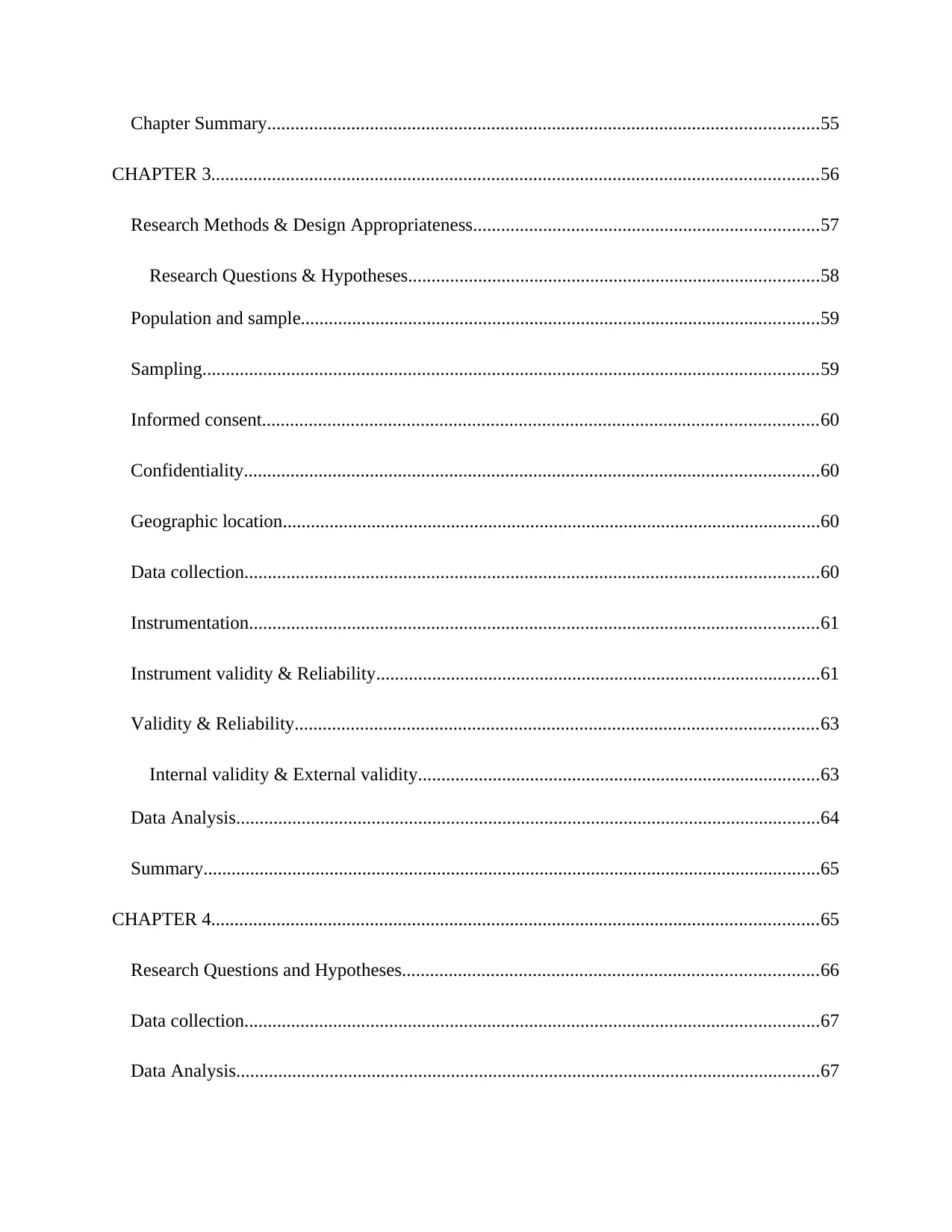
Chapter Summary......................................................................................................................55
CHAPTER 3..................................................................................................................................56
Research Methods & Design Appropriateness..........................................................................57
Research Questions & Hypotheses........................................................................................58
Population and sample...............................................................................................................59
Sampling....................................................................................................................................59
Informed consent.......................................................................................................................60
Confidentiality...........................................................................................................................60
Geographic location...................................................................................................................60
Data collection...........................................................................................................................60
Instrumentation..........................................................................................................................61
Instrument validity & Reliability...............................................................................................61
Validity & Reliability................................................................................................................63
Internal validity & External validity......................................................................................63
Data Analysis.............................................................................................................................64
Summary....................................................................................................................................65
CHAPTER 4..................................................................................................................................65
Research Questions and Hypotheses.........................................................................................66
Data collection...........................................................................................................................67
Data Analysis.............................................................................................................................67
CHAPTER 3..................................................................................................................................56
Research Methods & Design Appropriateness..........................................................................57
Research Questions & Hypotheses........................................................................................58
Population and sample...............................................................................................................59
Sampling....................................................................................................................................59
Informed consent.......................................................................................................................60
Confidentiality...........................................................................................................................60
Geographic location...................................................................................................................60
Data collection...........................................................................................................................60
Instrumentation..........................................................................................................................61
Instrument validity & Reliability...............................................................................................61
Validity & Reliability................................................................................................................63
Internal validity & External validity......................................................................................63
Data Analysis.............................................................................................................................64
Summary....................................................................................................................................65
CHAPTER 4..................................................................................................................................65
Research Questions and Hypotheses.........................................................................................66
Data collection...........................................................................................................................67
Data Analysis.............................................................................................................................67
Paraphrase This Document
Need a fresh take? Get an instant paraphrase of this document with our AI Paraphraser
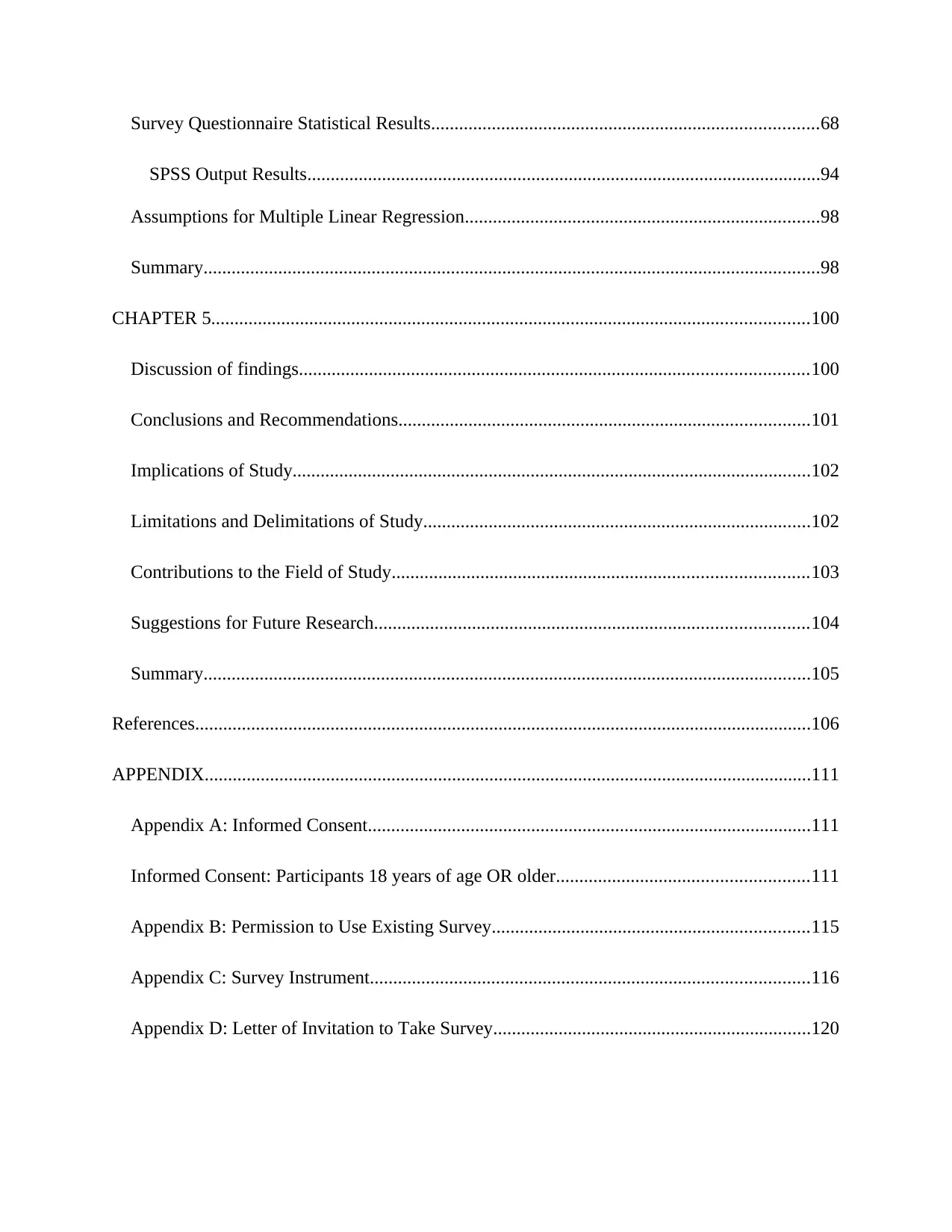
Survey Questionnaire Statistical Results...................................................................................68
SPSS Output Results..............................................................................................................94
Assumptions for Multiple Linear Regression............................................................................98
Summary....................................................................................................................................98
CHAPTER 5................................................................................................................................100
Discussion of findings.............................................................................................................100
Conclusions and Recommendations........................................................................................101
Implications of Study...............................................................................................................102
Limitations and Delimitations of Study...................................................................................102
Contributions to the Field of Study.........................................................................................103
Suggestions for Future Research.............................................................................................104
Summary..................................................................................................................................105
References....................................................................................................................................106
APPENDIX..................................................................................................................................111
Appendix A: Informed Consent...............................................................................................111
Informed Consent: Participants 18 years of age OR older......................................................111
Appendix B: Permission to Use Existing Survey....................................................................115
Appendix C: Survey Instrument..............................................................................................116
Appendix D: Letter of Invitation to Take Survey....................................................................120
SPSS Output Results..............................................................................................................94
Assumptions for Multiple Linear Regression............................................................................98
Summary....................................................................................................................................98
CHAPTER 5................................................................................................................................100
Discussion of findings.............................................................................................................100
Conclusions and Recommendations........................................................................................101
Implications of Study...............................................................................................................102
Limitations and Delimitations of Study...................................................................................102
Contributions to the Field of Study.........................................................................................103
Suggestions for Future Research.............................................................................................104
Summary..................................................................................................................................105
References....................................................................................................................................106
APPENDIX..................................................................................................................................111
Appendix A: Informed Consent...............................................................................................111
Informed Consent: Participants 18 years of age OR older......................................................111
Appendix B: Permission to Use Existing Survey....................................................................115
Appendix C: Survey Instrument..............................................................................................116
Appendix D: Letter of Invitation to Take Survey....................................................................120

⊘ This is a preview!⊘
Do you want full access?
Subscribe today to unlock all pages.

Trusted by 1+ million students worldwide
1 out of 105
Related Documents
Your All-in-One AI-Powered Toolkit for Academic Success.
+13062052269
info@desklib.com
Available 24*7 on WhatsApp / Email
![[object Object]](/_next/static/media/star-bottom.7253800d.svg)
Unlock your academic potential
Copyright © 2020–2025 A2Z Services. All Rights Reserved. Developed and managed by ZUCOL.





